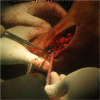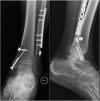Flexible fixation of syndesmotic diastasis using the assembled bolt-tightrope system
- PMID: 24053432
- PMCID: PMC3849036
- DOI: 10.1186/1757-7241-21-71
Flexible fixation of syndesmotic diastasis using the assembled bolt-tightrope system
Abstract
Background: Syndesmotic diastasis is a common injury. Syndesmotic bolt and tightrope are two of the commonly used methods for the fixation of syndesmotic diastasis. Syndesmotic bolt can be used to reduce and maintain the syndesmosis. However, it cannot permit the normal range of motion of distal tibiofibular joint, especially the rotation of the fibula. Tightrope technique can be used to provide flexible fixation of the syndesmosis. However, it lacks the ability of reducing the syndesmotic diastasis. To combine the advantages of both syndemostic bolt and tightrope techniques and simultaneously avoid the potential disadvantages of both techniques, we designed the assembled bolt-tightrope system (ABTS). The purpose of this study was to evaluate the primary effectiveness of ABTS in treating syndesmotic diastasis.
Methods: From October 2010 to June 2011, patients with syndesmotic diastasis met the inclusion criteria were enrolled into this study and treated with ABTS. Patients were followed up at 2, 6 weeks and 6, 12 months after operation. The functional outcomes were assessed according to the American Orthopedic Foot and Ankle Society (AOFAS) scores at 12 months follow-up. Patients' satisfaction was evaluated based upon short form-12 (SF-12) health survey questionnaire. The anteroposterior radiographs of the injured ankles were taken, and the medial clear space (MCS), tibiofibular overlap (TFOL), and tibiofibular clear space (TFCS) were measured. All hardwares were routinely removed at 12-month postoperatively. Follow-ups continued. The functional and radiographic assessments were done again at the latest follow-up.
Results: Twelve patients were enrolled into this study, including 8 males and 4 females with a mean age of 39.5 years (range, 26 to 56 years). All patients also sustained ankle fractures. At 12 months follow-up, the mean AOFAS score was 95.4 (range, 85 to 100), and all patients were satisfied with the functional recoveries. The radiographic MCS, TFOL, and TFCS were within the normal range in all patients. After hardware removal, follow-up continued. At the latest follow-up (28 months on average, (range, 25 to 33 months) from internal fixation), the mean AOFAS score was 96.3 (range, 85 to 100), without significant difference with those assessed at 12 months after fixation operations. No syndesmotic diastasis reoccurred based upon the latest radiographic assessment.
Conclusions: ABTS can be used to reduce the syndesmotic diastasis and provide flexible fixation in a minimally invasive fashion. It seems to be an effective alternative technique to treat syndesmotic diastasis.
Figures








References
MeSH terms
LinkOut - more resources
Full Text Sources
Other Literature Sources
Medical
Miscellaneous

